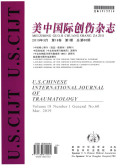- 钛学术文献服务平台 \
- 学术期刊 \
- 医药卫生期刊 \
- 外科学期刊 \
- 美中国际创伤杂志期刊 \
Six Years Follow-up of Spinal Tuberculosis Treated by Anterior Debridement, Instrumentation and Bone Grafting
Six Years Follow-up of Spinal Tuberculosis Treated by Anterior Debridement, Instrumentation and Bone Grafting
基本信息来源于合作网站,原文需代理用户跳转至来源网站获取
摘要:
Tuberculosis of the spine comprises approximately 50% of all skeletal cases. 50 years ago,costotranseversectomy was the preferred surgical treatment. The primary limitation of costotranseversectomy has the difficulty exposing the entire phlegmon. Frequently multiple debridement were required to adequately remove all evidence of infection. In the 1970s, posterior debridement was used. Posterior debridement also had many disadvantages, including long-term bed rest, increased risk of pulmonary and urinary infection, poor fusion rate, and high recurrence rate of infection,and residual kyphosis [1]. Because of the limitations with posterior and posterior lateral approaches, anterior approaches for debridement, instrumentation,and bone grafting are more commonly used today.Anterior treatment will prevent progression of kyphosis, prevent recurrence, and protect the position of the graft material.

推荐文章
Twitter的Follow关系和Retweet关系对比
在线社交网络
网络数据分类
同质性
推特网
Follow ur Heart随心所动
自动变速
骑行
变速器
自行车
Six1在宫颈癌组织中的表达及意义
宫颈肿瘤
基因,同源盒
Six1
免疫组织化学
肿瘤浸润
肿瘤转移
HeLa细胞
大肠癌组织中Six1和CyclinD1的表达及其临床意义
大肠癌
Six1
CyclinD1
浸润
转移
内容分析
关键词云
关键词热度
相关文献总数
(/次)
(/年)
引文网络
引文网络
二级参考文献 (0)
共引文献 (0)
参考文献 (2)
节点文献
引证文献 (0)
同被引文献 (0)
二级引证文献 (0)
2001(1)
- 参考文献(1)
- 二级参考文献(0)
2003(1)
- 参考文献(1)
- 二级参考文献(0)
2007(0)
- 参考文献(0)
- 二级参考文献(0)
- 引证文献(0)
- 二级引证文献(0)
引文网络交叉学科
相关学者/机构
期刊影响力
美中国际创伤杂志
主办单位:
美国中华医学会
出版周期:
季刊
ISSN:
1538-814X
CN:
开本:
出版地:
陕西西安市南稍门红会路3号西安市红十字会医院
邮发代号:
创刊时间:
语种:
chi
出版文献量(篇)
1584
总下载数(次)
2
总被引数(次)
885
期刊文献
相关文献
推荐文献

 免费查重
免费查重










